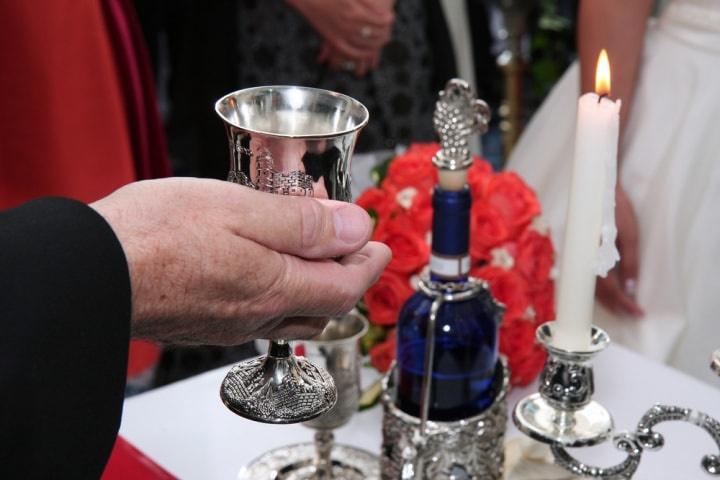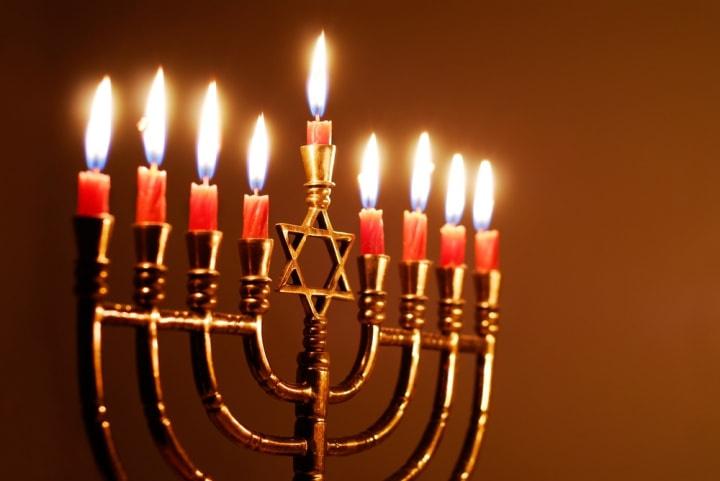Table of contents
 Surprise
Surprise
Judaism understands marriage as a divine and sacred union, in which two souls are reunited and become one. But not only that, it also considers this bond as one of the pillars on which humanity stands.
The Kudishin, which is the name given to a Jewish wedding, is translated as sanctification and contemplates two successive acts: on the one hand, the Erusin, which corresponds to the betrothal ceremony, and on the other, the Nissuin, which is the celebration of the Jewish wedding itself.
If you profess this religion and wish to get married under its laws, here you will find answers to all your questions.
Location and clothing
A Jewish marriage can take place outdoors or in a temple, the only requirement is that it must take place under a wedding canopy called a chuppah.
This Wedding chuppah consists of an open structure, supported by four pillars and covered by light fabrics, in allusion to Abraham and Sarah's tent. According to tradition, it has an entrance on all four sides to welcome visitors arriving from any direction.
The Jewish chuppah, which is a symbol of hospitality and protection, represents the new home that will be constituted and shared by the spouses.
Meanwhile, for a Jewish wedding, the attire is very simple for the Khatan and for the Kalah, groom and bride in Hebrew: she will wear a white dress, while he will wear a Kittel, which corresponds to a white tunic, as well as a Kippah on his head.

Fasting and reception
On the day of their marriage, both bride and groom will should keep fasting from dawn until the end of the ceremony. This is done to honor the sanctity of the day and to arrive at the celebration completely clean in spirit.
But also, the engaged couple cannot see each other during the week prior to the wedding. Therefore, upon arrival at the wedding venue, the bride and groom will meet and greet the guests separately, staying in different rooms. This moment is known as Kabalat Panim.
Thus, while the bride is honored and praised by the rest of the women, the men accompany the groom to the signing of the Tnaim, which is the contract that establishes the conditions imposed by the bride and groom and their parents on the Jewish marriage commitment, a provisional contract that will later be replaced by the Ketuvah.
To close this preamble, the mothers of the engaged couple break a plate, symbolizing that if something is to be broken, it should be that plate and not the union between the couple.
Badeken or lowering of the veil
Minutes before the beginning of the ceremony, the Badeken or lowering of the veil takes place, which is the the first time the bride and groom cross each other's eyes during that day.
At this moment, which is otherwise very emotional, the groom approaches the bride and lowers the veil over her face. This act symbolizes that love is deeper than physical beauty, while the soul is supreme and fundamental. But the Badeken also represents the man's commitment to clothe and protect his wife.
While it is customary to leave the bride and groom alone for the veiling, it is also possible for their family and close friends to witness this ritual.
Beginning of the ceremony
After the Badeken, the bride and groom walk to the chuppah, first the groom walks accompanied by his mother or godmother, and then the bride with her father or godfather, or each one can enter the chuppah accompanied by his father and mother.
It should be noted that, in a Jewish marriage ceremony, the parents do not "give" the daughter to the husband, but rather it is a union between families .
Meanwhile, before the wedding begins, the bride circles seven times around the groom under the chuppah. This rite symbolizes the creation of the world in seven days, the seven divine qualities, the seven portals of mercy, the seven prophetesses and the seven shepherds of Israel. It is a way of endowing the new family they are about to forge with blessings.
And at the same time it means that it is in the power of the woman to build the external walls that protect the home, as well as to tear down the internal walls that weaken the family. Also, according to their beliefs, the spiritual root of the woman is of a higher level than that of the man, so through these turns the bride transmits to the groom her spirituality.

Erusin
With the woman positioned to the right of the man, the ritual begins with the rabbi reciting the Kiddush, which is the blessing over the wine, followed by the Birkat Erusin, which corresponds to the betrothal blessings.
Then the bride and groom drink a glass of wine, the last one as bachelors and they consecrate themselves to each other by exchanging their wedding rings which should be plain gold rings without ornaments.
At that moment, the groom places the ring on the index finger of the bride's right hand and pronounces the following words: "You are consecrated to me with this ring according to the law of Moses and Israel". And optionally, the bride also places a ring on her groom and declares: "I am my beloved's and my beloved belongs to me". All this, in the presence of two witnesses who must not haveblood relationship with the contracting parties.
While originally it was only the man who gave the ring to the woman, Reform Judaism allows the exchange of Jewish wedding rings today to be mutual.
After the rings are placed, the Ketubah or marriage contract is read in the original Aramaic text, which details the responsibilities and obligations that correspond to the groom, or to the groom and the bride, seeking equality, if it is a Reform Jewish wedding.
The rabbi then reads aloud the Ketubah, and then the bride, groom and witnesses proceed to sign the document, thus acquiring legal validity.
Nissuin
Once the contract has been signed, the second stage of the ceremony begins with the bride and groom hearing the Seven Blessings or Sheva Brachot These blessings, which express gratitude to God for the miracle of life and the joy of marriage, are recited by the rabbi or any other person the bride and groom wish to honor. Since the number seven represents integrity, it is customary for seven different people to recite the blessings.
After finishing the Sheva Brachot, the bride and groom cover themselves with the Talit, which is a flowing robe that symbolizes that the groom is consecrated exclusively to his wife, and then they drink the second cup of wine, but the first one as a married couple.
The officiant then pronounces a blessing in the Jewish ceremony and declares the couple married under the laws of their religion.
Breaking the cup
Finally, a glass tumbler is placed on the floor to be stepped on and shattered by the groom. This act marks the end of the ceremony .
What does it mean? It is a tradition that symbolizes the sadness for the destruction of the Temple of Jerusalem, and that identifies the couple with the spiritual and national destiny of the Jewish people. It evokes the fragility of the human being.
But the shattering of the glass also has another meaning, and that is that it inaugurates the celebration that is about to take place. After the rite is over, the guests cheer the newlyweds with the expression "mazel tov!

Yijud or The Enclosure
But once married, jewish marriage customs don't stop As soon as the ceremony is over, the couple moves to a private room, where they will be alone for a few minutes.
This act is called Yijud, in which the newly wedded husband and wife share a consommé to break the fast and, if they wish, exchange gifts. Only then are they ready to begin the feast.
Food and party
At the beginning of the meal, a loaf of bread will be blessed. as a sign of the bond between families of both spouses.
As for the menu, you can't eat pork, seafood, or mix meat with milk, according to their religious traditions, but you can eat beef, poultry, lamb or fish, for example, which can always be accompanied with wine, a drink that is a symbol of union and rejoicing in Jewish culture.
Once the banquet is over, the Seudah begins, which is a joyful party, with lots of dancing, acrobatics and a tradition that does not go unnoticed: the spouses are lifted up by the guests, seated on their chairs, alluding to the custom of carrying the kings in the same way on their thrones.
How does the marriage end? Family and friends recite the Seven Blessings again, with a glass of wine in hand, and with shouts of good luck they bid the newlyweds farewell.

Marriage Requirements
In order for the marriage to be valid, Jewish law requires that both parties must united of their own free will, who are single, and who are Jewish. .
However, several synagogues now perform ceremonies in which one of the partners is a convert. However, women can marry both Jewish and non-Jewish men, while men can only marry women who are Jewish by birth. This is because only from a Jewish womb can Jews be born, since the Jewish soul and identity are inherited from the mother. While thepractice of Judaism is fathered by the father, according to their beliefs.
In addition, the bride and groom must present the Ketubah, which is the marriage certificate of their parents or, in case they are separated, the Guet, which implies the religious divorce.
Finally, tradition dictates that the ideal is to fix the wedding within the first lunar waxing cycle, since it augurs happiness and fortune for the new spouses. But on the contrary, in consideration of Shabbat, which is a day dedicated to rest (the seventh of the week in the Jewish religion), a wedding cannot be celebrated between sunset on Friday and sunset on Saturday. Nor can a wedding be celebrated between sunset on Friday and sunset on Saturday. Nor can a wedding be celebrated between sunset on Saturday and sunrise on Saturday.may marry on the days preceding the biblical Jewish feasts or during major religious holidays, which are mandated days of rest.
Judaism is one of the oldest religions in the world and its traditions are respected to this day. However, it is possible that certain practices may be modified, in accordance with the new times, as long as the essential postulates are not touched.
We help you find the ideal place for your wedding Ask for information and prices of Celebration to nearby companies Consult prices
